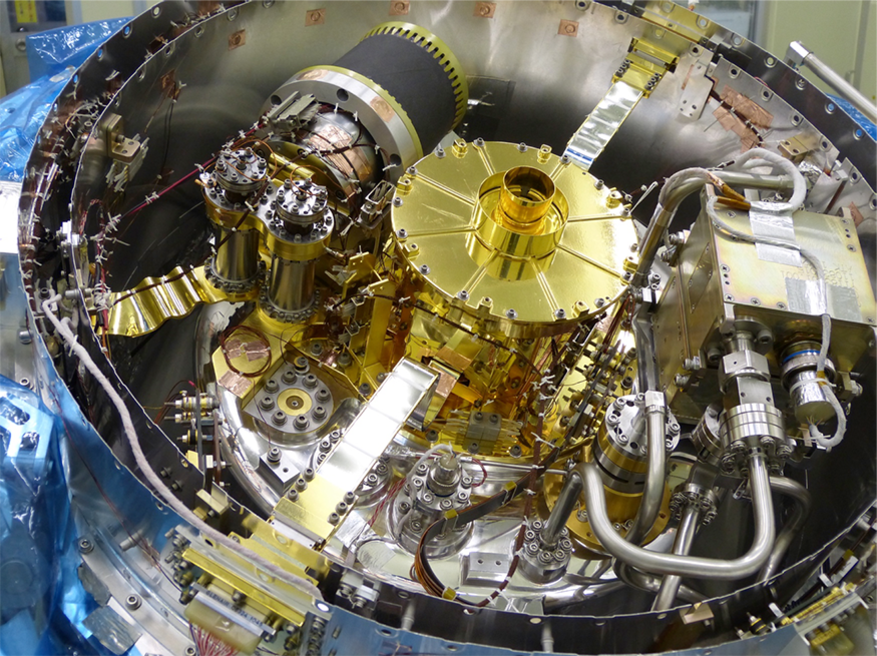Resolving astronomical mysteries
The Resolve detector measures tiny temperature changes created when an x-ray hits its 6-by-6-pixel detector. Each photon heats the material by an amount directly proportional to its energy. By measuring each individual x-ray’s energy, the instrument provides information about the source, such as its composition, motion, and physical state. (Photo: NASA's Goddard Space Flight Center, view the full XRISM Resolve Animation)
A new satellite called XRISM (X-ray Imaging and Spectroscopy Mission, pronounced “crism”) was successfully launched from the Tanegashima Space Center in Japan on Sep. 7, 2023. XRISM is a collaboration between the Japan Aerospace Exploration Agency (JAXA) and National Aeronautics and Space Administration (NASA), with European Space Agency participation, to study extreme environments in the cosmos using x-ray light.
The development of XRISM’s core instrument, a high-resolution x-ray microcalorimeter spectrometer known as Resolve, was led by scientists at NASA’s Goddard Space Flight Center and Japan’s Institute of Space and Astronomical Science with support from researchers at Lawrence Livermore National Laboratory (LLNL).
“XRISM’s launch marks a major milestone for our team of scientists and technicians at LLNL who worked for years to prepare the Resolve instrument,” said Megan Eckart, who serves as the lead calibration scientist for Resolve. “We are grateful for the support we received at LLNL and from our external collaborators that allowed hands-on work to continue during the pandemic, including in Japan.”
Understanding Resolve
Whereas the energy of visible light is 2 to 3 electron volts, Resolve was designed to detect X-rays with energies ranging from 300 to 12,000 electron volts. This range provides astrophysicists with new information about some of the universe’s hottest regions, largest structures and objects with the strongest gravity. Ultimately, Resolve will give researchers a new look at how some of the universe’s most energetic objects behave, including black holes, galaxy clusters, and the aftermath of stellar explosions.
Resolve’s detector is housed in the Calorimeter Spectrometer Insert (CSI) within a dewar, allowing X-ray light focused by an X-ray mirror assembly at the front of the spacecraft to reach the detector. Resolve can then measure tiny temperature changes created when an X-ray hits its 6-by-6-pixel detector. To detect these tiny temperature changes, the detector needs to cool down to around minus 460 degrees Fahrenheit (minus 273 degrees Celsius), just a fraction of a degree above absolute zero. It reaches this state using mechanical coolers, liquid helium and a final cooling stage called an adiabatic demagnetization refrigerator.
At such cold temperatures, the array can measure the slight amount of heat generated when a pixel absorbs a single X-ray photon. The miniscule temperature increase is measured by sensitive electronics, and onboard software infers the precise energy of the incoming photon. By measuring each individual X-ray’s energy, the instrument provides information about the source, such as its composition, motion and physical state.
Using the thousands or even millions of X-rays from a cosmic source, Resolve also can measure an object’s high-resolution spectra. Spectra are measurements of light’s intensity over a range of energies. Prisms spread visible light into different energies, which are better known as the colors of the rainbow. Scientists used prisms in early spectrometers to look for spectral lines, which occur when atoms or molecules absorb or emit energy.
Resolve will capture the most detailed spectra to ever be obtained for a wide variety of objects in the universe, helping researchers learn more about the structure and evolution of the universe, the creation and distribution of heavy elements, and how energy and matter are transported and circulated in regions of strong gravity, electromagnetic fields and shock waves.
Pre- and post-launch operations
Leading up to the launch, the LLNL team supported Resolve’s performance and calibration campaigns, from component-level laboratory testing to on-spacecraft system tests. Multiple LLNL-led calibration campaigns were conducted at synchrotrons, such as Lawrence Berkeley’s Advanced Light Source and the Canadian Light Source, where the team measured the X-ray transmission of the instrument’s components. This effort included the calibration of all the flight-candidate thin-film optical/infrared dewar blocking filters and thin-film thermal shield of the X-ray telescope, some of the most fragile components in the entire instrument.
Additional efforts focused on calibrating the detector’s array at multiple levels of assembly — from early tests in non-flight configurations to testing campaigns in the fully assembled, flight-like configuration, as well as component verification during spacecraft-level thermal vacuum testing. These efforts included campaigns at NASA Goddard and JAXA’s Tsukuba Space Center from 2018-2022. During this time, the LLNL team refurbished and deployed an electron beam ion trap (EBIT) for the campaigns at Goddard to provide X-ray emission lines key to the low-energy (<1.5 keV) spectroscopic calibration.
Once the instrument was ready to be transported to the launch site, the LLNL team supported post-shipment checkout and launch-site operations at the Tanegashima Space Center. Through January, the team will continue to support in-orbit commissioning at the Sagamihara Spacecraft Operations Center at JAXA’s Institute of Space and Astronautical Science, checking and verifying the functionality of the satellite and onboard instrumentation.
As XRISM moves past the commissioning phase, LLNL scientists will be heavily involved in the in-flight calibration program and scientific observations, performing laboratory astrophysics measurements at Livermore’s EBIT facility to support the community in interpreting Resolve spectra.
“We are excited about the XRISM data to come and plan to host analysis working meetings at the Laboratory’s open collaboration spaces over the next year,” said Greg Brown, group leader of the Astrophysics and Advanced Diagnostics group and LLNL’s XRISM point of contact with NASA.
Additional contributions to this work include LLNL’s Ed Magee, Angelique Mangoba, Harrison Flores-Alimboyoguen, Natalie Hell, Tom Lockard and Alex Fairchild, as well as visiting scientists from the US, Europe, and Japan.
—Shelby Conn
Contact
 Anne M. Stark
Anne M. Stark
[email protected]
(925) 422-9799
Tags
Physical and Life SciencesAstrophysics
Physics
Space
Space Science Institute
Featured Articles








